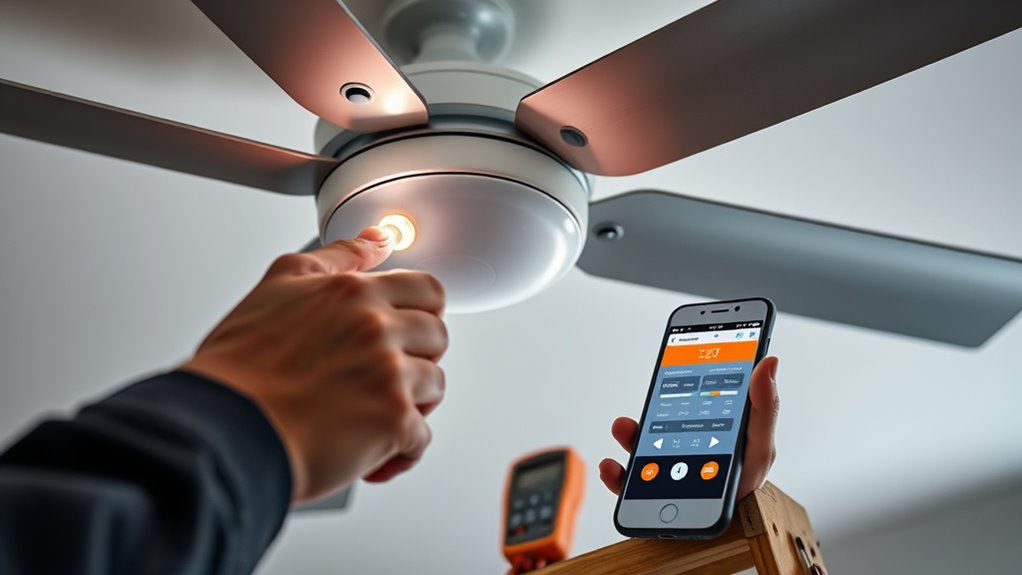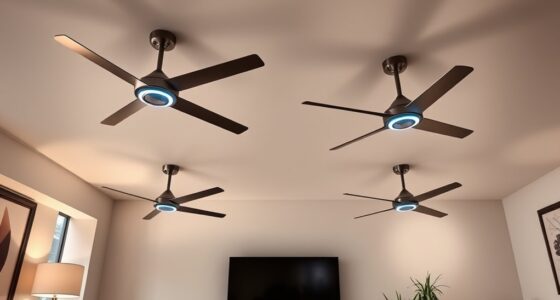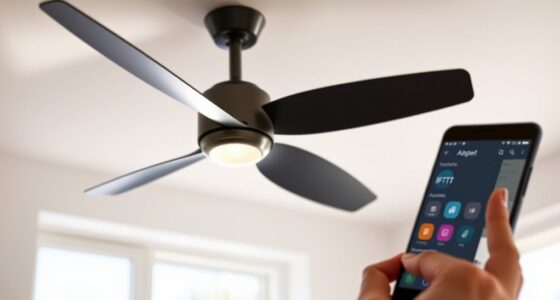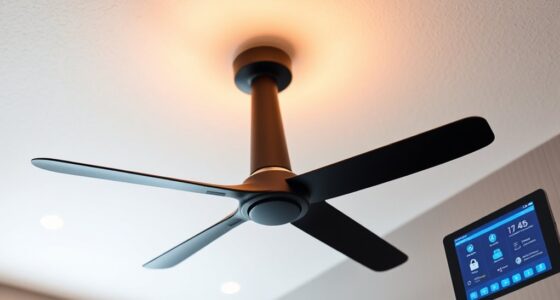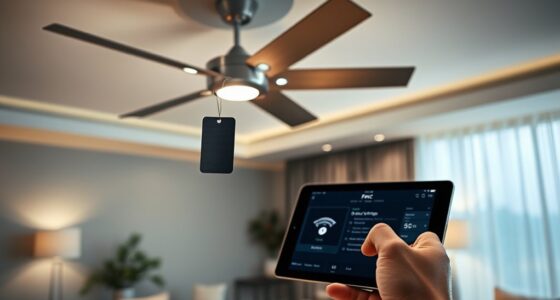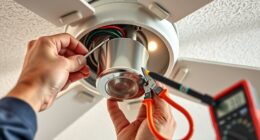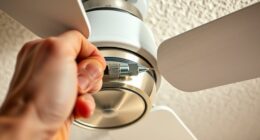To troubleshoot your smart ceiling fan’s connectivity issues, first verify electrical supply by checking circuit breakers, wall switches, and wiring connections for any damage or looseness. Then, confirm your Wi-Fi network is stable, operating on the same band (preferably 2.4 GHz), and free of interference from other devices. Restart your router, fan, and app, update firmware, and reset settings if needed. Understanding these details will help you identify and resolve most connection problems effectively.
Key Takeaways
- Verify power supply, circuit connections, and switch positions to ensure the fan is properly powered.
- Confirm Wi-Fi network stability, same band (preferably 2.4 GHz), and minimize interference sources.
- Check Bluetooth settings and proximity if using Bluetooth control; ensure devices are within 30 feet.
- Update firmware regularly, restart devices, and reinstall the app to resolve software-related connectivity issues.
- Perform factory or network resets, reconfigure Wi-Fi settings, and confirm network stability before reconnecting.
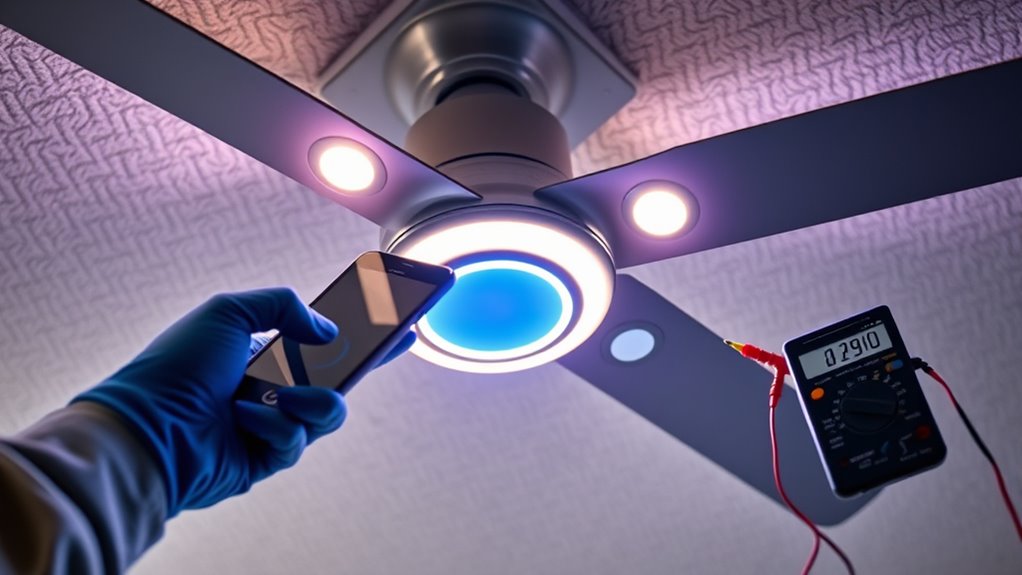
Ceiling fan connectivity issues can disrupt airflow and comfort, often stemming from electrical or wireless communication faults. When your smart ceiling fan refuses to respond to commands or fluctuates between operational modes, it’s essential to diagnose the underlying causes precisely. These issues typically involve either power supply disruptions, faulty wiring, or wireless communication failures, each requiring targeted troubleshooting steps. First, verify that the fan is receiving proper electrical power. Check the circuit breaker or fuse box to ensure the circuit controlling the fan isn’t tripped or blown. If your fan has a dedicated wall switch, confirm it’s in the ON position and functioning correctly. Sometimes, a loose connection or faulty switch can interrupt power flow, causing connectivity problems. Additionally, inspect the wiring connections at the fan’s canopy for loose or damaged wires, especially the line, neutral, and ground. Tighten any loose terminals and replace damaged wires to restore proper electrical continuity.
Wireless communication issues often stem from interference or weak signals between the fan and your control device, such as a smartphone or smart hub. Confirm that your Wi-Fi network is operational and stable. Use a device to check internet connectivity and ensure the network isn’t overloaded with traffic. If the fan connects via Bluetooth, verify that Bluetooth is enabled on your controlling device and that you’re within the effective range—usually about 30 feet. Signal interference from other wireless devices, thick walls, or electronic appliances can weaken communication. To mitigate this, try relocating your Wi-Fi router closer to the fan or removing potential sources of interference. Also, confirm that the fan and control device are on the same network band—2.4 GHz networks generally provide better range for smart devices than 5 GHz.
Firmware or app malfunctions frequently cause connectivity issues. Make sure your smart fan’s firmware is up to date; manufacturers regularly release updates to enhance stability and fix bugs. Open the dedicated app and check for available updates, then follow the instructions to install them. If the app fails to communicate with the fan, try restarting both your smartphone and the fan’s hub or Wi-Fi module. Reinstalling the app can also resolve glitches caused by corrupted data or software conflicts. Resetting the fan’s network settings can sometimes clear persistent issues; consult your user manual for specific instructions on performing a factory reset or network reset. This process often involves pressing a reset button or turning the fan off and on in a specific sequence, restoring the device to factory defaults. Reconfigure the fan’s Wi-Fi settings afterward, ensuring the credentials are correct and the network is stable.
Additionally, understanding the technology behind smart ceiling fans can help troubleshoot compatibility and connectivity issues more effectively.
Frequently Asked Questions
How Do I Reset My Smart Ceiling Fan to Factory Settings?
To reset your smart ceiling fan to factory settings, locate the reset button usually found on the fan’s motor housing or control panel. Press and hold the button for about 10-15 seconds until you see the LED indicator flash or change color. Release the button, and the fan will revert to factory defaults. This clears all custom settings and disconnects it from your network, ready for reconfiguration.
Can I Connect My Smart Fan to Multiple Devices Simultaneously?
Yes, you can connect your smart fan to multiple devices simultaneously. Most smart fans support multi-device pairing through their dedicated app or integrated Bluetooth/Wi-Fi protocols. To do so, verify each device is within range and properly configured with the same network. Follow the manufacturer’s instructions to add additional devices, usually involving accessing the fan’s Bluetooth or Wi-Fi settings and pairing each device sequentially. Keep firmware updated for best multi-device connectivity.
What Should I Do if the App Can’t Find My Fan?
If the app can’t find your fan, first make certain the fan is powered on and within Bluetooth or Wi-Fi range. Restart the fan and your device, then reopen the app. Check for any firmware updates for the fan and app. Confirm your network connection is stable. If still unresolved, reset the fan to factory settings and attempt the pairing process again, ensuring your app permissions are properly granted.
Is There a Way to Update the Fan’s Firmware Manually?
Imagine guiding a delicate butterfly to its resting spot; updating your fan’s firmware requires careful navigation. You typically can’t manually update firmware directly; instead, verify your app and device are connected to Wi-Fi. Check for firmware updates through the app’s settings—usually under “Device Info” or “Firmware.” Follow prompts if an update is available; if not, restart your app and fan, then try again. Keep your device close and connected for seamless updates.
How Do I Troubleshoot Bluetooth vs. Wi-Fi Connectivity Issues?
To troubleshoot Bluetooth versus Wi-Fi connectivity issues, first verify the fan’s network settings. For Bluetooth, ensure the device is within close proximity, Bluetooth is enabled, and no interference exists. For Wi-Fi, check your network strength, password accuracy, and firmware updates. Restart your router and fan, then reattempt pairing. Use diagnostic apps if available, and consult the user manual for specific troubleshooting steps related to your model.
Conclusion
By systematically checking your Wi-Fi signal, firmware updates, and remote batteries, you can resolve most connectivity issues. Remember, a stitch in time saves nine—addressing problems early prevents larger faults down the line. Guarantee your smart fan’s network settings are correctly configured and your device firmware is current. If issues persist, consult the manufacturer’s troubleshooting guide or contact support. Staying methodical and attentive to detail ensures your smart ceiling fan operates seamlessly and reliably over time.
